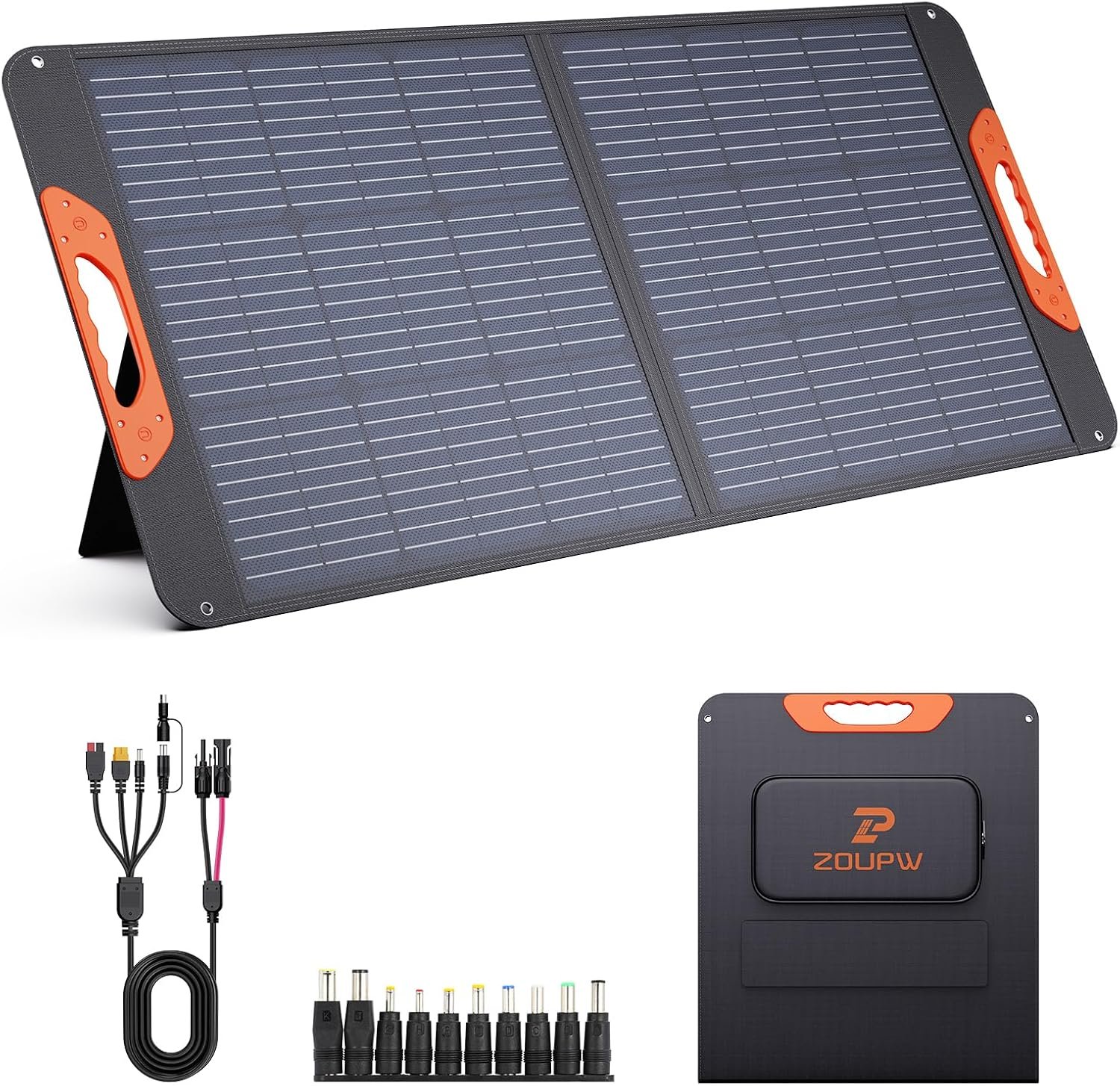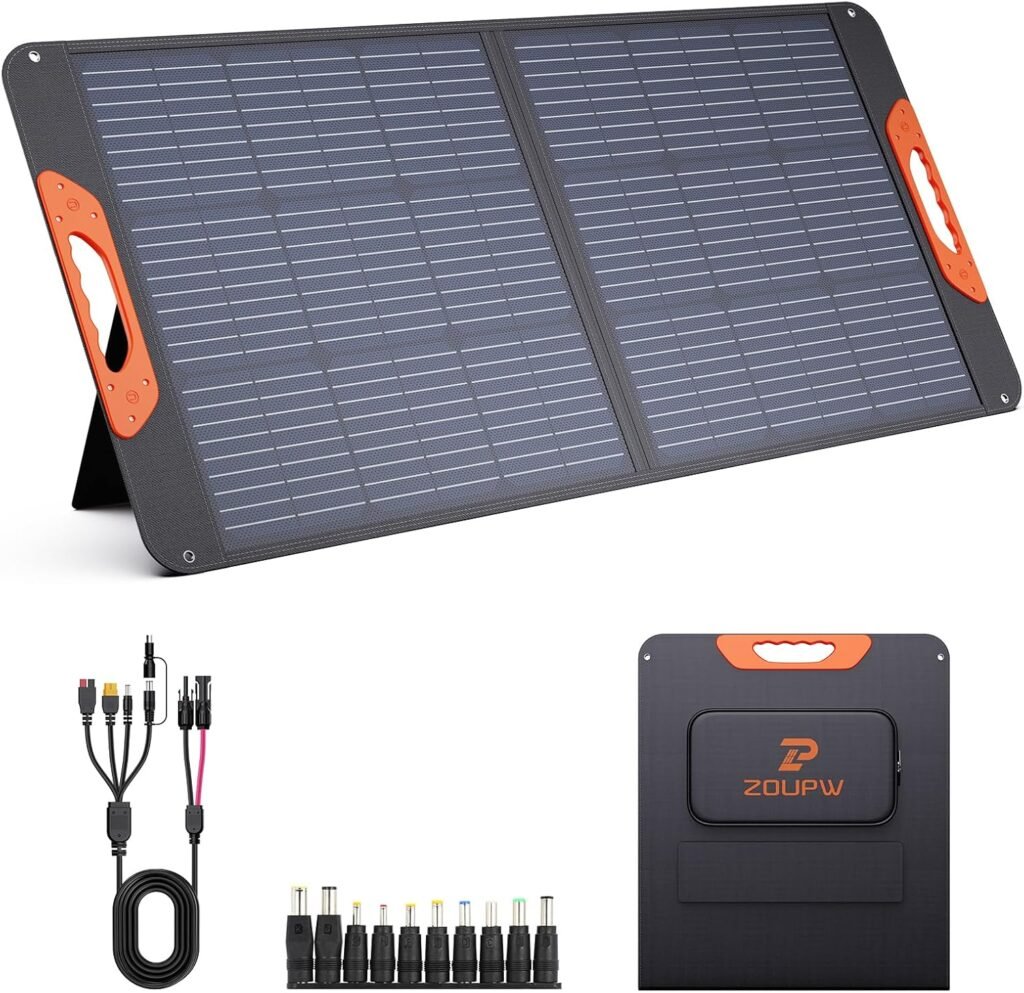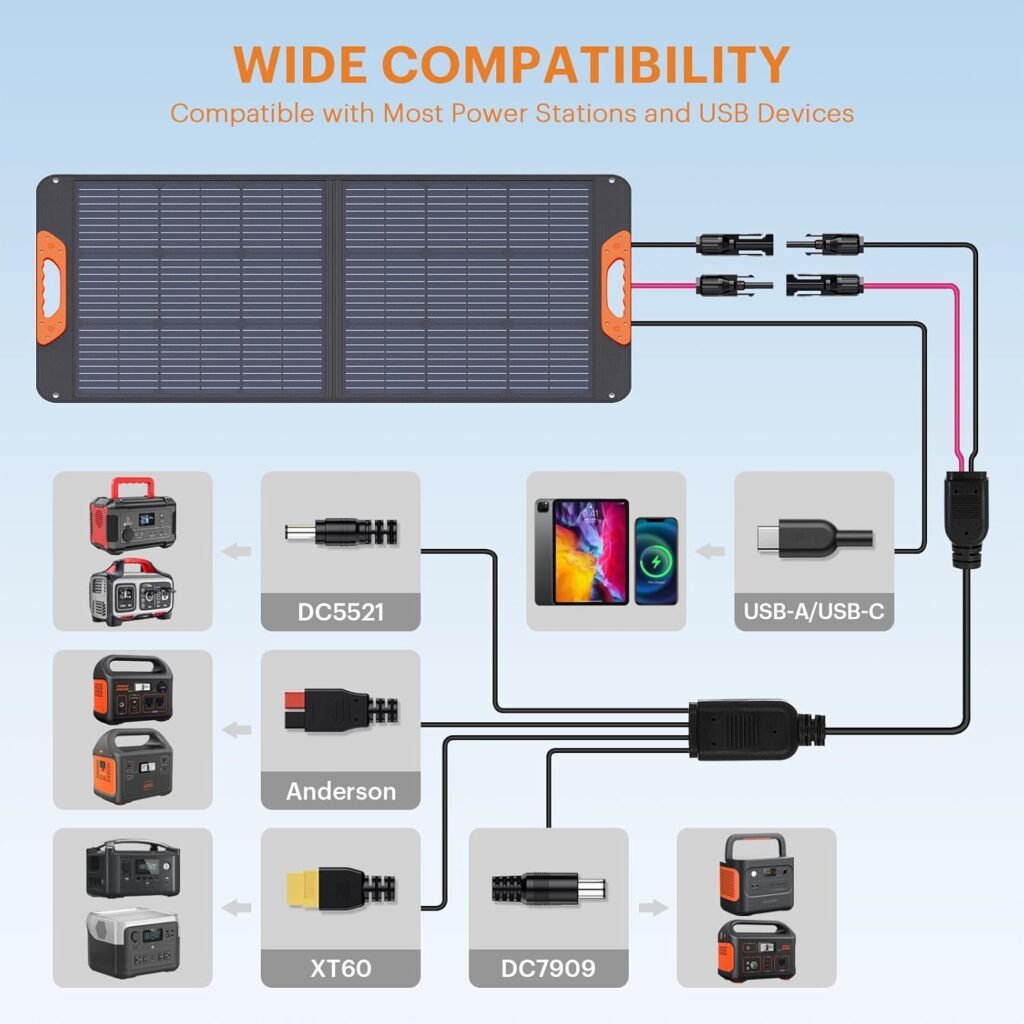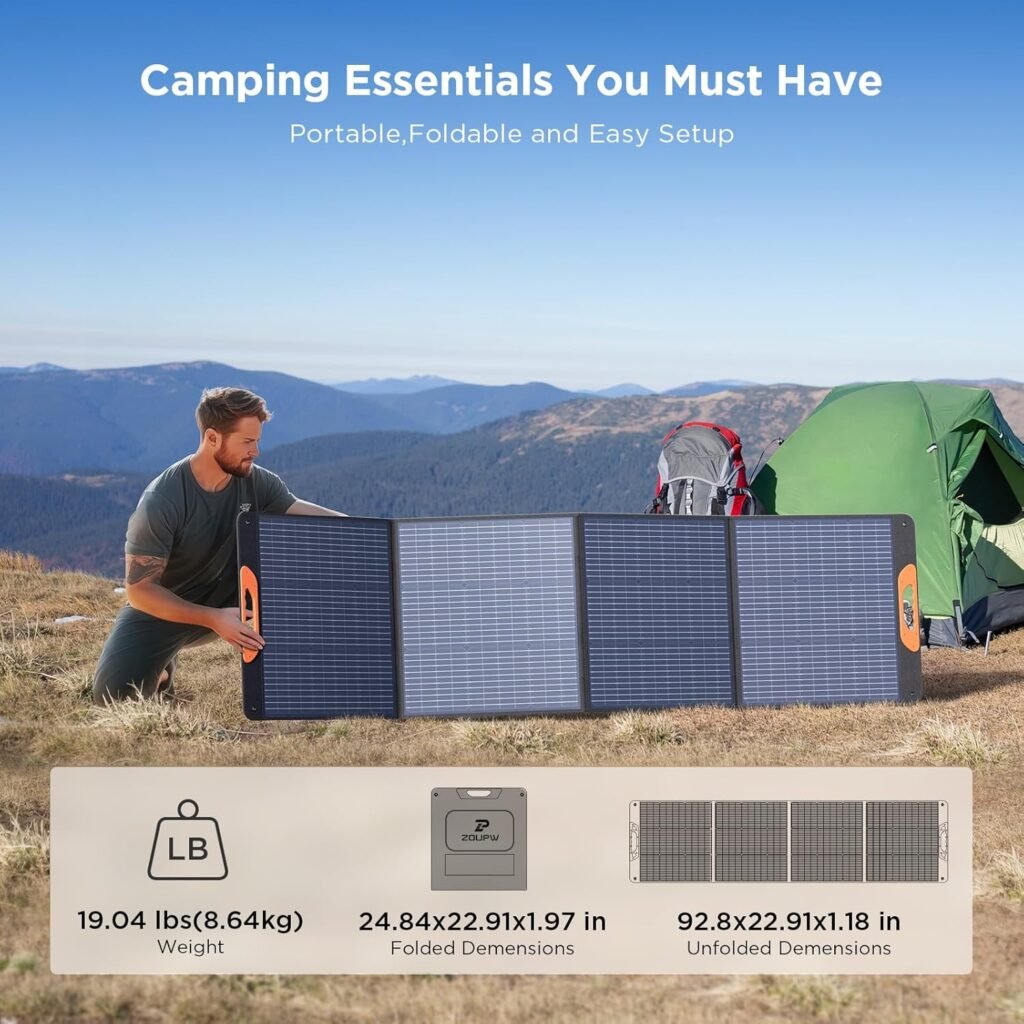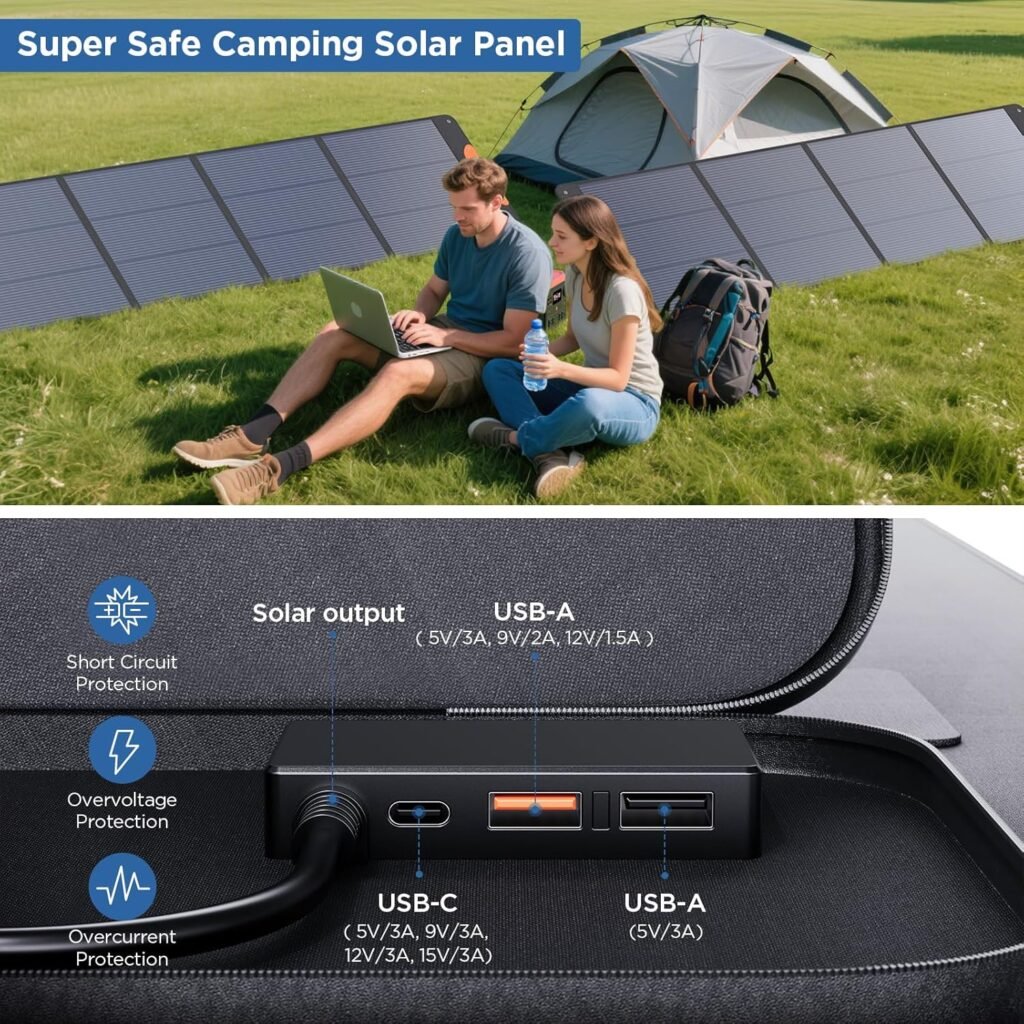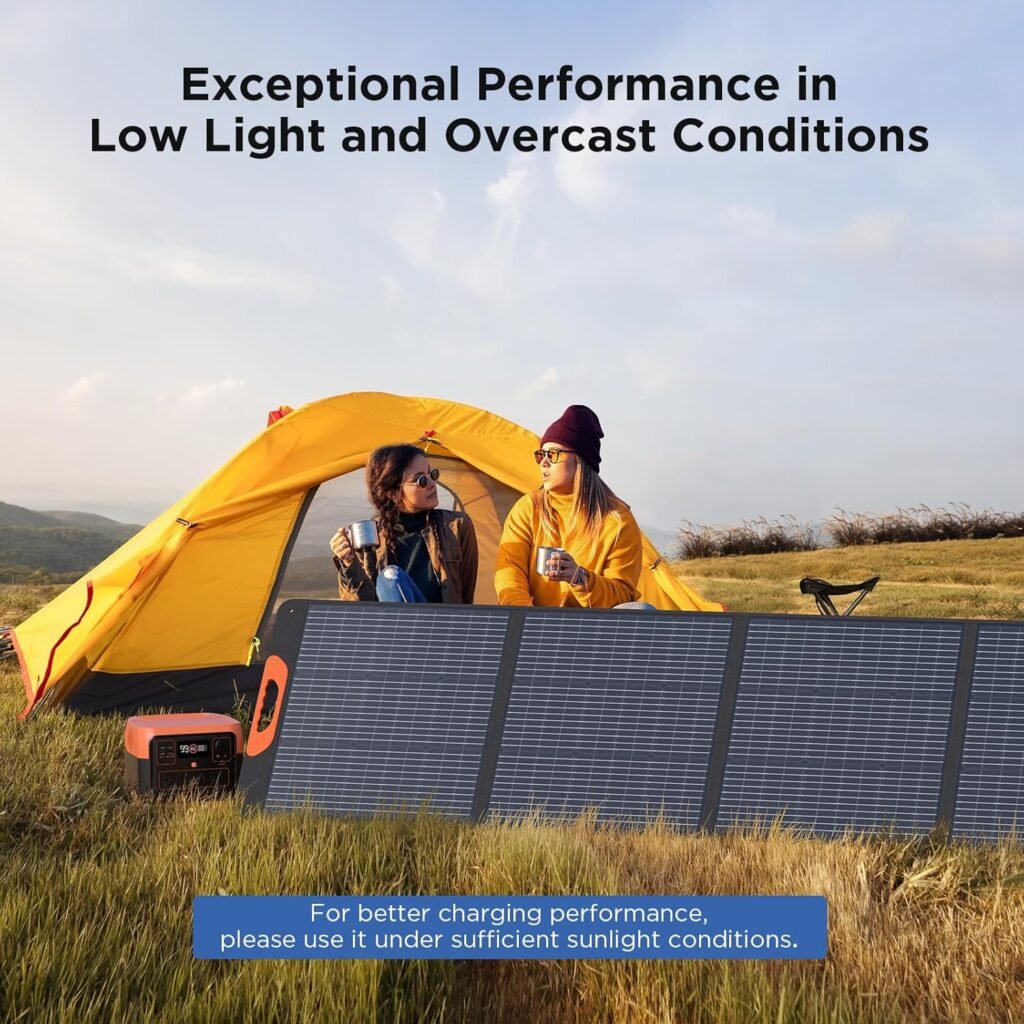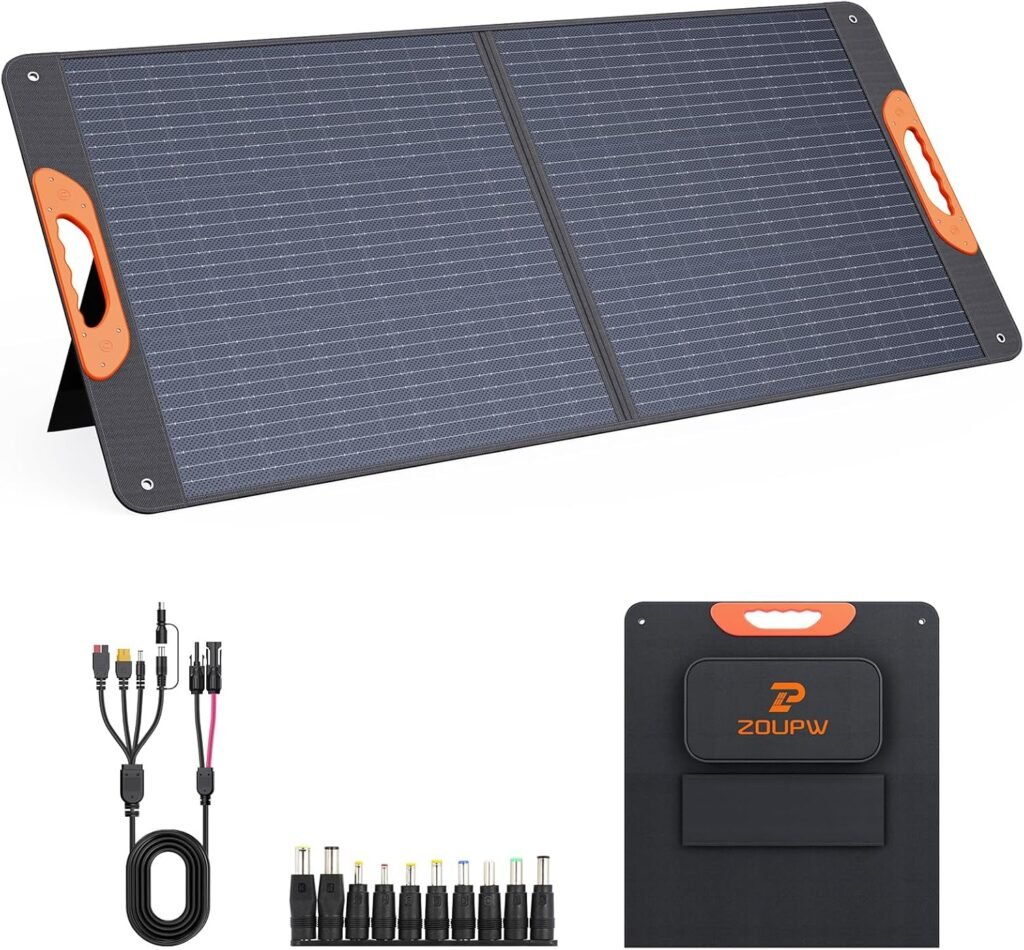100W Portable Solar Panel RV Essentials review
Have you ever needed reliable solar power on the go and wondered which foldable panel actually delivers when it matters?
Product Overview: 100W Portable Solar Panel,RV Essentials, 20V ETFE Foldable Solar Charger for Power Station,QC3.0 USB-A &Type-C Output,23.5% High Efficiency IP67 Waterproof for Camping RV Hurricane
This section gives you a quick snapshot of what this unit promises and how it’s positioned for outdoor and emergency use. You’ll learn the headline specs and what to expect from the build and basic functionality.
This 100W foldable solar panel is built around A+ monocrystalline cells with a claimed 23.5% conversion efficiency and an ETFE-coated surface for durability and weather resistance. It’s aimed at campers, RV owners, and anyone who needs portable solar to charge power stations and smaller USB devices.
Key features at a glance
You’ll find the most relevant attributes listed here so you can decide quickly if this panel meets your needs. Each item covers a core selling point and why it matters to you.
- 100W nominal output using A+ monocrystalline cells (23.5% conversion efficiency)
- ETFE coating with IP67 waterproof rating for the panel surface
- Foldable, portable design with magnetic handle and two kickstands
- Controller with USB-A (5V/3A), orange USB-A (12V/1.5A), and Type-C (15V/3A)
- 10ft 4-in-1 solar extension cable (XT60/ANDERSON/DC5521/DC7909) for broad compatibility
- Smart IC protection and reverse charging protection on solar output
- Weight: 9.48 lbs; folded size: 24.13 x 21.06 x 1.77 inches
- Included accessories: 10ft extension cable, 10-in-1 DC connector, user manual
- Warranty: 12 months + 30-day money-back guarantee and 24/7 customer service
Technical Specifications
You’ll want a consolidated view of specs before making a buying decision. The table below gives you a clear breakdown of technical data and what each spec means for real-world use.
| Specification | Detail | What it means for you |
|---|---|---|
| Rated Power | 100W | Peak power under ideal sun and angle; useful for estimating charge time when paired with a power station |
| Cell Type | A+ Monocrystalline | Higher efficiency and better performance in limited light compared to polycrystalline |
| Conversion Efficiency | 23.5% | High efficiency means more power per surface area |
| Output Voltage | 20V (panel) | Typical for charging many portable power stations designed for solar input |
| USB Outputs | 1x Black USB-A (5V/3A), 1x Orange USB-A (12V/1.5A), 1x USB-C (15V/3A) | Direct charging for phones, tablets, and some USB-C laptops that accept 15V |
| Solar Connector | Solar controller + 10ft 4-in-1 cable | Broad compatibility with many power station brands and connectors |
| Material/Coating | ETFE | Durable, UV-resistant, and water-resistant surface that lasts longer than PET in many cases |
| Water Resistance | IP67 (panel surface) | Panel can resist dust and withstand immersion to a degree; control box not waterproof |
| Weight | 9.48 lbs | Relatively light for a 100W foldable — good for carrying and campsite use |
| Folded Dimensions | 24.13 x 21.06 x 1.77 inches | Compact enough for car storage and RV compartments |
| Accessories | 10ft 4-in-1 cable, 10-in-1 DC connectors | Extra connectors reduce the need for adapters |
| Warranty | 12 months + 30-day MBG | Backed by a basic manufacturer warranty and money-back guarantee |
Build Quality and Materials
You’ll notice the materials used here are chosen to balance portability with durability. This section explains what those materials mean for longevity and everyday handling.
The panel uses A+ grade monocrystalline silicon cells which are reliable and space-efficient. The ETFE coating is a standout — it’s tougher than standard PET and offers better UV and abrasion resistance. The exterior pocket for the controller keeps cables tidy and reduces the chance of losing the control box while you’re moving.
Be aware that although the panel surface is IP67-rated, the controller and its electronics are not completely waterproof. You should avoid submerging the control box or leaving it soaked for long periods to prevent damage and extend lifespan.
Frame, hinges, and portability
The foldable design includes reinforced hinges and a magnetic handle that makes carrying comfortable. Two integrated kickstands let you get the angle right quickly. At 9.48 lbs and with compact folded dimensions, you’ll find it very manageable to carry and position by yourself.
Performance in Real Conditions
You’ll want to know how this panel behaves under real sun, partial cloud, and in different angles. This section covers realistic expectations rather than lab-perfect numbers.
Under bright, direct sunlight with optimal tilt and orientation, you can expect output heading toward the 100W rating, though real-world factors usually lower peak numbers. The high cell efficiency helps maintain better output in marginal light compared to lower-efficiency panels. Morning and late afternoon sun will yield lower power, but the ETFE coating helps the panel stay cleaner and more effective over time.
What affects power output
Several environmental and system factors will change how much power you actually get:
- Angle and orientation to the sun: Small angle adjustments can significantly raise output.
- Cloud cover and atmospheric conditions: Overcast skies reduce power; heavy clouds can drop output severely.
- Temperature: High temperatures can slightly reduce the panel’s voltage and efficiency.
- Connector compatibility and power station input limits: Some power stations cap solar input; that cap, not the panel, may limit charging rate.
Charging and Compatibility
You’ll be pleased with the broad compatibility options provided, but you must check your power station’s input specs before relying on full 100W charging.
The included 10ft 4-in-1 cable with XT60, Anderson, DC5521, and DC7909 plugs covers most widely used outdoor power stations. Even so, many power stations have a maximum solar input limit—sometimes lower than 100W. That means you might not see a full 100W into the station even under perfect sunlight due to the station’s internal limit. This is a common scenario and not an indication of weak panel performance.
USB outputs and device charging
You can charge phones, tablets, and smaller USB devices directly from the controller. The smart IC chips automatically negotiate charging voltage and current, improving both efficiency and safety. The Type-C port supports up to 15V/3A, which covers many tablets and some laptops that accept 15V PD. The orange USB-A (12V/1.5A) is useful for devices that expect 12V through a USB-A style connection.
Setup and Angle Optimization
You’ll be able to set this up quickly at camp or while preparing an emergency kit. The dual kickstands and foldable design make initial placement and repositioning straightforward.
Place the panel so the surface faces the sun directly and adjust the hinges to fine-tune the angle. Use the kickstands for stability; if you’re on uneven ground, stabilize the panel with rocks or straps to prevent wind from toppling it. The magnetic handle helps during transport, but when set up, you’ll want both kickstands engaged.
Tips for maximizing output
- Keep the panel clean of dust, dirt, and bird droppings; ETFE helps but does not replace basic cleaning.
- Change tilt during the day if possible to follow higher sun angles.
- Avoid shading even a small portion of the cells, as partial shading can reduce the overall output.
- Use the shortest practical cable run between the panel and power station to reduce losses.
Portability and Practical Use
You’ll find the panel’s weight and folded size suitable for car trips, RV use, and hiking-to-campsite scenarios where vehicle access is available. The foldable format is balanced between surface area for higher power and portability for transport.
At roughly 9.48 lbs, it’s light enough to carry short distances without strain. The included handle and fold design are convenient for stowing in a trunk, RV storage compartment, or alongside camping gear.
Durability and Weather Resistance
Durability is a major selling point. The ETFE coating improves resistance to UV light and scratches, and the IP67 rating on the panel surface provides confidence in wet weather. You’ll still need to protect the controller from direct water exposure and prolonged submersion — the control box isn’t waterproof.
If you plan to leave the panel outside for extended periods, secure it against wind and consider retracting the controller into a dry bag or vehicle if stormy conditions are expected.
Safety Features and Protection
You’ll appreciate the built-in safety features as they reduce risk to both your devices and the panel itself. Smart IC circuitry helps prevent overvoltage, overcurrent, short circuit, and overtemperature conditions.
Reverse charging protection on the solar output protects your panel and any connected power station in case of unexpected wiring situations. These protections contribute to safer operation when you’re out in the field and possibly handling gear in adverse conditions.
Pros and Cons
You’ll want a straightforward list to help summarize the major benefits and limitations before deciding. Here are key points to weigh.
Pros:
- High 23.5% cell efficiency yields better real-world output for size.
- ETFE coating improves longevity and resistance to weathering.
- Wide compatibility via included 4-in-1 cable and multiple USB outputs.
- Lightweight and foldable with practical carrying features and kickstands.
- Smart charging with multiple protections for devices and panel.
- IP67 on the panel surface gives confidence in wet environments.
Cons:
- Control box is not fully waterproof; avoid soaking or submersing it.
- Some power stations may limit input below 100W, restricting max charge rate.
- Type-C output supports up to 15V/3A only — won’t fast-charge laptops that need higher PD wattages.
- No built-in battery — panel generates power but cannot store it; you’ll need a separate power station or battery.
Real-World Examples and Use Cases
You’ll see this panel fit into several practical scenarios. These use cases highlight how it performs depending on needs and environment.
- Weekend Camping: You’ll keep phones, lights, and small appliances topped up, and you can trickle-charge a medium power station for overnight runs.
- RV Road Trips: You’ll augment RV batteries or charge portable power stations while parked, reducing reliance on campground hookups.
- Emergency Preparedness: You’ll have a compact solar source that supports emergency radios, phones, and small medical devices during outages or hurricanes.
- Day Hikes to Basecamp: If you can transport a 9.48 lb panel by vehicle to your basecamp, you’ll enjoy higher charging capacity without the bulk of rigid panels.
Comparison with Similar Panels
You’ll encounter other 100W foldable panels; here’s how this one generally compares.
- Efficiency: At 23.5%, the panel is above average for portable models, giving it better power density.
- Material: ETFE is a step up from many foldables that use PET lamination.
- Portability: Weight and folded size are competitive; some ultra-light options are lighter but sacrifice output or durability.
- Connections: The included 4-in-1 cable is a real convenience compared with panels that require separate adapters.
- Waterproofing: IP67 on surface is solid; many competitors claim water resistance but lack an equal rating.
Maintenance and Care
You’ll keep this panel in good shape with a few simple practices that extend life and ensure reliable performance.
- Clean the ETFE surface with a soft cloth and mild soapy water when dirty. Avoid abrasive cleaners and sharp tools.
- Store the controller and cables in the panel’s pocket or a dry bag when not in use.
- Avoid leaving the control box submerged or exposed to heavy, prolonged rain.
- Inspect hinge points and stitching on the fabric case periodically; repair small tears promptly to prevent larger damage.
Troubleshooting Tips
You’ll likely resolve common issues quickly with these practical steps.
- If you see low output: Verify panel orientation and tilt, ensure no shading, and check the connector is fully seated.
- If a power station isn’t charging: Confirm the station’s solar input limit and match the connector type. Try a different adapter on the included 10-in-1 connectors.
- If USB devices aren’t charging: Test with known-good cables and devices to rule out cable wear or device faults. Check ports for debris.
- If the control box gets wet: Power down and dry completely before using again. Avoid returning it to service until fully dry to prevent shorts.
Frequently Asked Questions (FAQ)
You’ll probably have some common questions; here are clear answers to help you decide and use the panel properly.
Q: Can this panel charge a laptop directly? A: You can charge laptops that accept 15V via USB-C at up to 45W (15V/3A) depending on the laptop’s charging requirements. Laptops needing higher PD voltages or wattages will require a power station or an adapter that supports higher input.
Q: Does the panel store energy? A: No. The 100W panel generates electricity but does not include an internal battery. You’ll need a separate power station or battery to store energy.
Q: Is the controller waterproof? A: No. The panel surface is rated IP67, but the control box is not waterproof. Keep the controller dry to prolong its lifespan.
Q: Will this panel produce 100W all the time? A: The 100W rating is peak output under ideal conditions. Real-world output depends on sun angle, cloud cover, temperature, and whether your power station imposes an input cap.
Q: What if my power station has a max input below 100W? A: The panel can produce more than your station accepts, but the station will only draw up to its maximum input. This is a limitation of the power station, not the panel.
Final Verdict
You’ll find this 100W Portable Solar Panel to be a solid choice if you need a balance of high efficiency, portability, and durability. The ETFE surface and 23.5% monocrystalline cells give you better power for surface area and longer usable life than many competitors. The inclusion of a 10ft 4-in-1 cable and a variety of USB outputs means you can connect to a wide range of devices and power stations right away.
It’s not a replacement for a full fixed solar array or a built-in RV system, but for portable, on-the-go power to support camping, RV trips, and emergency preparedness, you’ll appreciate how usable and reliable this panel is. Just remember to protect the control box from water, verify your power station’s input limits, and plan for a separate power station if you need energy storage.
Buying Tips and What to Check Before You Order
You’ll reduce surprises by confirming a few things before buying.
- Check your portable power station’s maximum solar input and connector compatibility.
- Confirm that your important devices are compatible with the available USB voltages and currents.
- Decide whether you need an inverter or higher PD wattage; if so, plan to pair this panel with a suitable power station that can convert and store energy.
- Consider whether you’ll frequently use the panel in harsh conditions—if so, the ETFE and IP67 elements are beneficial, but you’ll still need to protect the controller.
Closing Notes
You’ll have a dependable and efficient portable solar solution with this unit, especially when paired with a compatible power station. It’s thoughtfully designed with portability, ruggedness, and real-world convenience in mind. If you prioritize high efficiency, durability, and broad connector compatibility for outdoor or emergency use, this panel is a strong contender.
Disclosure: As an Amazon Associate, I earn from qualifying purchases.
